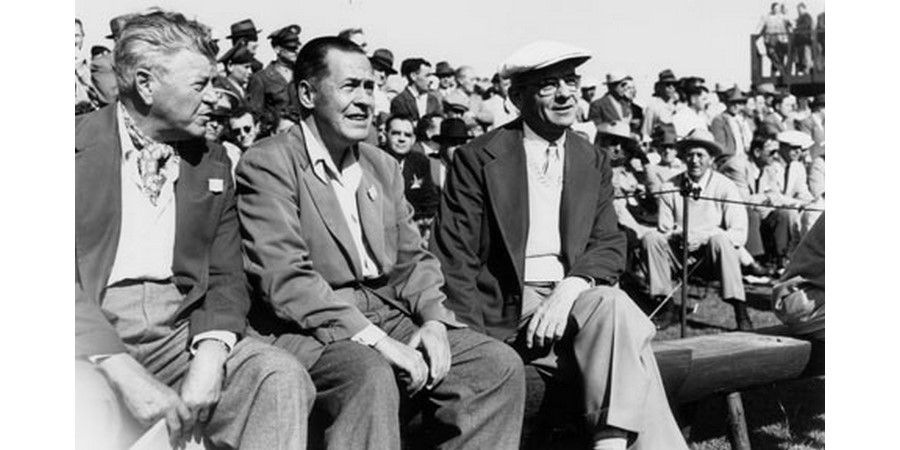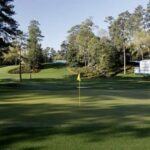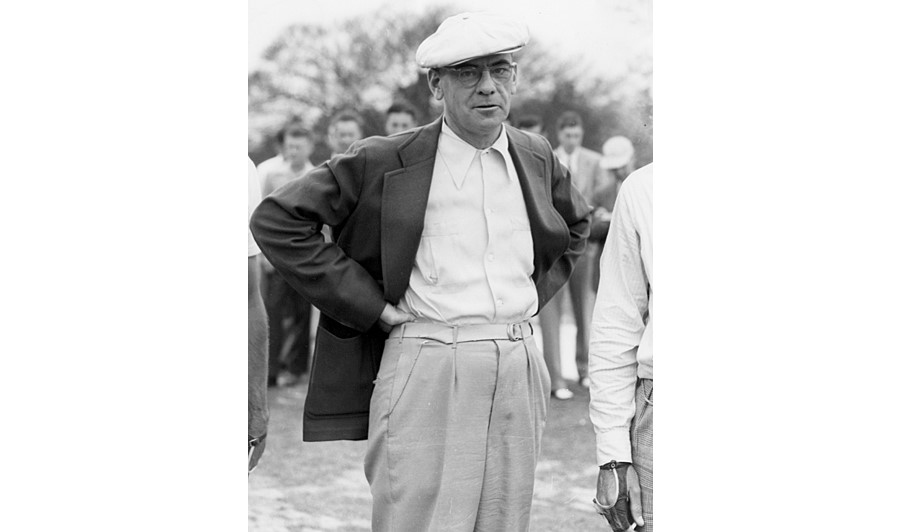The singular element that has long separated The Masters from any other golf event, and likely any other global sporting event, is the resolute fixation on getting the details right.
As in all the details right.
The Augusta National Golf Club is viewed with both awe and deference.
This year marks the 87th edition of golf’s annual first Major and the iconic event would never have reached the lofty position it occupies today without someone keeping a close eye on a myriad of matters, both large and small.
Two men provided the lift-off for Augusta National. The outward public face was Bobby Jones, the celebrated golf champion and charismatic figure. He was revered for his self-effacing manner and his razor-sharp capacity in raising his game to the highest of levels.
On the flip side was Clifford Roberts, the quintessential insider and the man responsible for putting into motion a game plan executed with utter precision each year. It is that laser-like focus that separates The Masters from any other event in golf.
Roberts was keen to always keep his eye and ears open. Improving Augusta was always the mantra. Not simply making changes for change’s sake.
Roberts first met Jones back in the 1920s at Knollwood CC in Westchester County, NY. Born March 6, 1894 in Morning Sun, Iowa. Roberts was a farm boy who eventually found his way to Wall Street. His smarts and wherewithal to act quickly when situations presented themselves had him reach partner status at Reynolds & Company where he stated for the rest of his career.
With Jones as the ‘outward’ face of Augusta National, it was Roberts who was the consummate insider. Jones would be named the club’s President in perpetuity after his death at 69 in 1970. Roberts served as the club’s first chairman from 1931 until his death in 1977 when he committed suicide at age 83 after suffering a severe health decline. Ironically, the actions Roberts took followed in lockstep with how both of his parent died.
No matter his final ending, Roberts would be named chairman in memoriam. His fingerprints indelibly embedded on the character and soul of Augusta National and The Masters.
The vision of Jones and Roberts was to create a national membership for the club. The original purchase price of $70,000 came about via an option on a 365-acre property called Fruitland Nurseries.
Jones was well aware of Augusta from previous golf visits to the area and the close proximity to his home town of Atlanta allowed him the benefit of enjoying both.
Jones enlisted the renowned Yorkshire architect Alister MacKenzie to work with him in designing the course. The American was enthralled with MacKenzie’s efforts in creating Cypress Point in California. Jones had competed in the 1929 US Amateur at nearby Pebble Beach and, after being eliminated from the event, was invited to play Cypress Point. Jones was fascinated with the course and endeavored to have MacKenzie be his point person for the design of Augusta National.
Both men revered The Old Course at St Andrews and each wanted to create an inland parkland course embodying the links-like characteristics of that Scottish gem.
Construction started in 1931 with a limited play opening in 1932. The formal opening took place in January, 1933 and the first Masters occurred in 1934 with Horton Smith the inaugural champion.
The event was called the Augusta National Invitation Tournament until 1939 because Jones believed it was pretentious to use the word Masters. Jones eventually relented and the new name found a permanent home.
What many fail to comprehend is that the opening of Augusta National faced serious macro issues. The Great Depression was already in full motion. Additional complications would come shortly thereafter when World War II enveloped the globe.
Jones was revered in a sports-crazy America. His greatest triumph came in 1930 when he won the four Major golf events of the time. The Grand Slam triumph included the Open and Amateur titles of the USA and the United Kingdom. No man had ever before held all four at the same time in one calendar year.
The rigours of competition caused Jones to retire from active competition at the age of 28 following his Grand Slam triumph. Still, the magnetism of Jones served as the bedrock from which the foundation of Augusta National blossomed.
Roberts was the point person in getting the needed dollars from various deep-pocketed business people. Keeping the club going was anything but a sure thing and for a number of years was the central area of emphasis.
Unlike today, when tournament badges are completely sold out and even practice rounds require lucky individuals to secure access through a lottery, it was a far different story during the early years.
Roberts was resolute in keeping the club afloat and he reached out to those throughout the greater Augusta community to play a central supporting role.
While Jones was the public face for the new club it was Roberts who resolutely held firm in elevating a small invitational event into one that ultimately is viewed by many globally as the most prized championship with its much-celebrated Green Jacket bestowed on the winner.
When World Waw II receded into the shadows, the aura of The Masters was on the launching pad for stardom. Matters were helped considerably by the golf stars emerging. Names such as Jimmy Demaret, Sam Snead, Byron Nelson and Ben Hogan each won multiple Green Jackets.
Beyond the play of the top golfers, it was Roberts who devised a series of improvements that elevated The Masters even more so. He put in place a scoring system that made matters far more efficient in terms of keeping abreast of the golf competition. The tournament’s over/under scoring system shows contestants’ cumulative standing in relation to par. Hole-by-hole, red numerals indicate under-par scores, green numerals over-par scores and green zeroes even par.

Eleven leaderboards were strategically placed around the course, each listing the 10 lowest scores at a given time. There would also be other innovations including roped fairways, a complimentary tournament booklet and modest concession prices with free on-site parking. To ensure the beauty of the grounds, Roberts insisted rubbish bags be coloured green to blend in with the surroundings.
But there was a central man Roberts especially cultivated. One who never played in The Masters just like himself, but who occupied a position of even greater importance than either Jones or Roberts.
That man was Dwight D Eisenhower, the 34th President of the United States (1953-1961). Eisenhower was an avid golfer and Roberts invited him to visit Augusta National in 1948 and, not long after, extended him an invitation to join the club.
During his two terms as President, Eisenhower would visit Augusta National on 29 different occasions. More notably, it was Roberts who played a central role in leading the financing of the Eisenhower campaign for the White House.
To best illustrate the power dynamic, one need only understand the situation tied to the 17th hole. Eisenhower routinely sliced his tee shots. One solitary tree, located down the left side, effectively blocked his path to the green.
For the President the solution was simple… remove the tree. At a meeting of the membership Eisenhower stated his case and Roberts simply dismissed it and ended the discussion. In Washington DC, Eisenhower held sway. However, at Augusta National, the President of the United States needed to acquiesce to the chairman of the club.
Roberts was also keenly aware of the power of the press and how the media could greatly assist the fledgling event’s overall profile. Roberts used the enduring aura of Jones in cultivating key writers, notably Grantland Rice and OB Keeler. Both then reached out to other key writers, many returning from assignment in Florida during baseball’s spring training program and then coming to Augusta in early April for the tournament.
The two singular items that exponentially pushed the Masters to the highest of heights were sports being televised and, on the golf front, the charismatic reach of a golfer from western Pennsylvania.
Arnold Palmer presented a connection to those who previously viewed golf as the bastion of rich, white men. Palmer’s athletic style, combined with his All-American handsomeness and desire to swing aggressively at the ball, resonated.
Palmer would win The Masters on four different occasions between 1958 and 1964 and he would join with Jack Nicklaus and Gary Player in forming golf’s ‘big three’. From 1960 thru 1966, the Masters was won by one of the three.
Roberts was also astute in cementing a relationship with network television in which The Masters would be amplified in the precise manner that satisfied him. Unlike other major sports, The Masters bypassed signing a multi-year contract.
Brilliantly, Robert opted to implement a one-year contract with the CBS network, who televised The Masters for the first time in 1956. Only a few cameras were operating and only four holes were covered.
Keeping CBS on a short leash provided Roberts with increased leverage on how the broadcast specifically would be carried out. The Masters could have made more money with a multi-year deal but Roberts shrewdly saw control being the singular item of importance knowing full well other networks would be more than willing to follow suit if CBS were pushed out. Upon the conclusion of each year’s event Roberts would huddle with network brass and make clear his comments on what was expected. Roberts also insisted the awarding of the Masters Green Jacket be aired live on network television.
The main concern for CBS was Roberts’ post event interview involvement. The Augusta National chairman had a halting conversational style and the network was always on edge re what he might say. That fear came to pass at the conclusion of the 1965 event when Roberts announced, without network awareness, that the 1966 Masters would be the first to be televised in colour. Network officials were aghast because no such dialogue with Roberts had taken place and it knew that a technological advancement of that magnitude would come at a significant added cost.

Related: Augusta’s holes ranked from 1 to 18 – Part 3
In 1964, just three per cent of the American population owned a colour TV. Nonetheless, CBS knew that drawing a line in the sand could well mean Roberts shopping The Masters elsewhere. In the end, CBS blinked and The 1966 Masters was the first to be in colour.
Roberts was keen to ensure The Masters, and by extension the Augusta National Golf Club, was always seen in the most positive manner. To magnify his reach he would intervene with a forceful hand when moments did arise.
The most noted came during the 1966 Masters when famed broadcaster Jack Whitaker stated at the conclusion of a playoff for that year’s event: “Here comes the mob.” It was a reference to a gallery surge on the 18th. Roberts took offence to this characterisation and not long after Whitaker was dropped.
The commentator always believed his removal was at the direction of Roberts and not CBS although he did return in 1972 and for several years afterwards. The simple lesson was clear; words spoken by announcers were monitored and could be acted upon as needed. Fast forward to 1994 when CBS announcer Gary McCord received a permanent boot. Claiming the 17th green had been “bikini waxed” and that “body bags” could be found for balls overshooting the green. The club made its intentions clear and it was McCord who then found himself in a permanent body bag of exile.
To this day, CBS instructs announcers to use such terms as the ‘second cut’ in reference to the minimal rough just off the fairways. There is also the usage of the word ‘patrons’ referring to those in attendance. Roberts also insisted there be no mention of the prize money being offered or any other matter not directly related to the event.

CBS was present to provide the club’s public relations game plan and not to include news matters deviating from that. The focus rested squarely on the players and the prestige in competing for golf’s most sought prize – The Green Jacket.
To foster the appropriate vibe the Masters selects which companies advertise during the event. You won’t see ads for dog food, pizza deliveries and other non-descript products. Initially, Cadillac and Travelers Insurance were the two long-time sponsors. Now, six companies have the honors with AT&T, Mercedes Benz, UPS, Delta, IBM and Rolex involved. There was one other element to the sponsorship – The Masters mandated no more than four minutes of commercials during the telecast.
Roberts also played a leading role when the par-3 course opened in 1958. Working with architect George W Cobb, the layout provided another dimension to the event and eventually became part of the annual Wednesday festivities with a 9-hole tournament open to all invitees. Sam Snead, a three-time Masters winner, would claim the first title in 1960.
Roberts lived long enough to see the first black player, Lee Elder, compete in the 1975 Masters. Considerable outside pressure was placed on Roberts to extend an invitation to Elder and a few other notable players such as Charlie Sifford in years prior. In all of those situations Roberts refused to budge. This also meant no black or female members during his reign at Augusta National.
Was Roberts outside the mainstream in what was happening at the highest levels of golf then? Hardly. Other notable golf organizations and clubs throughout that time followed a similar path and up to 1961 the PGA of America had a clause in its operational bylaws that prohibited non-Caucasians from becoming members. The PGA Tour only insisted host clubs not be discriminatory in membership practices starting in 1991. Augusta National accepted its first black member in 1990.
By 1977 health issues were impacting Roberts‘ life. Cancer and a debilitating stroke pushed him to the brink and on September 29th, 1977 his body was found near Ike’s pond at the par-3 course with a self-inflicted gunshot. The club then took one extra step, naming Roberts chairman in perpetuity.
The gun Roberts used was a 38-caliber Smith and Wesson revolver. The club’s security force found the weapon and for some bizarre reason the gun eventually found itself in an auction catalog of golf memorabilia. The price? $15,000. Augusta National took steps to reacquire the gun for that amount.
The guiding principle for Roberts was a fierce independence highlighted through a steadfast desire to always protect and enhance Augusta National Golf Club and by extension The Masters.
When the health of Bob Jones was rapidly failing because of an incurable spinal disease, it was Roberts who believed Jones should no longer be part of the presentation ceremonies. Roberts believed his actions were only for the right reasons in preserving the dignity of Jones. The Jones family saw the matter in a different light and Roberts was not invited to Jones’ funeral in December, 1971.
Ultimately, Roberts was the man who held all the key cards and he valued his role as the ultimate gatekeeper. Control was his driving force and that desire extended all the way to his end where he controlled the circumstances of his final exit from the planet. The rise of The Masters is a testament to his willpower in overseeing all aspects and he was inducted into the World Golf Hall of Fame in 1978.
While various golfers gained fame from their exploits in front of the camera, it was Roberts at the helm calculating the endless array of behind the curtain actions that carefully cultivated the pageantry one sees each year during that special week in April.
Like any musical conductor, making sure the right notes were played at the right moment.
Clifford Roberts was indeed the meticulous maestro of The Masters.